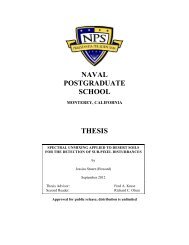October 2000 Newsletter - Naval Postgraduate School
October 2000 Newsletter - Naval Postgraduate School
October 2000 Newsletter - Naval Postgraduate School
You also want an ePaper? Increase the reach of your titles
YUMPU automatically turns print PDFs into web optimized ePapers that Google loves.
RESEARCH OVERVIEW<br />
MISSILE DEFENSE RESEARCH, continued from page 39<br />
provide good estimates of optical turbulence and laser propagation<br />
conditions in the atmosphere. To accomplish this they<br />
had to modify the turbulence closure assumptions in the<br />
COAMPS model so it could work correctly in the free<br />
atmosphere and stratosphere, and develop an optical turbulence<br />
parameterization scheme.<br />
Running the COAMPS mesoscale weather model on the<br />
High Performance Computing Machines located at the <strong>Naval</strong><br />
Oceanographic Office, Stennis Space Center, Mississippi, and<br />
the U.S. Army Engineer Research Center Laboratories,<br />
Vicksburg, Mississippi, they are able to predict atmospheric<br />
AN INVESTIGATION INTO ALTERNATIVE NATIONAL MISSILE DEFENSE SCHEMES<br />
LT James Kalowsky, USN<br />
LT Victor Lake, USN<br />
LT Stephen Meade, USN<br />
LT Robert Thompson, USN<br />
Ballistic missile defense is an important and controversial<br />
topic with no standard operational procedures in place today<br />
that could neutralize a ballistic missile threat. The issue of<br />
how to defend against an inbound, rouge state, nuclear<br />
ballistic missile was studied with focus on the two leading kill<br />
NMD Engagement CONOPS<br />
turbulence conditions 6-12 hours beyond the initial starting<br />
conditions. These predictions agree well with aircraft and<br />
balloon measurements of turbulence collected by NPS in<br />
CONUS and the U.S. Air Force in potential threat areas.<br />
NPS model results were included as a significant new<br />
capability during a critical program review presented by the<br />
ABL SPO to Dr. Hans Mark, Director of Defense Research<br />
and Engineering during the spring of this year. Because of<br />
the NPS success, the U.S. Air Force Research Laboratory has<br />
initiated their own effort to model optical turbulence within<br />
the atmosphere.<br />
mechanism options: nuclear and hit-to-kill. National<br />
Missile Defense (NMD) plans of the past and future were<br />
reviewed. Logistics and timeline problems were investigated<br />
and resulted in a likely engagement scenario. The hitto-kill<br />
option is a precision problem that is presently being<br />
worked on by the DoD, however it is still in the early stages<br />
of development. The nuclear option was investigated as to<br />
whether it could meet the requirements of ensuring destruction<br />
of an inter-continental ballistic missile in the near<br />
future. At the higher latitudes expected for the engagement,<br />
the effects of<br />
a nuclear environment<br />
in the exoatmosphere<br />
were<br />
studied, as well as<br />
the effects on<br />
spacecraft and<br />
satellite electronics.<br />
Also, the short-term<br />
degradation or<br />
blackout of sensor<br />
systems was studied,<br />
with particular<br />
interest given to<br />
early warning<br />
systems. Conclusions<br />
were drawn<br />
from the comparison<br />
between the hitto-kill<br />
approach and<br />
the nuclear option.<br />
NPS Research page 40<br />
<strong>October</strong> <strong>2000</strong>
















